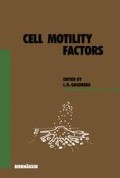Summary
In studying the role of motility in the metastasis of tumor cells, we have described an autocrine motility factor. This agent, which stimulates random motility, probably contributes to the initial dissociation of the cells from the primary tumor mass. Extracellular matrix components, via several different mechanisms, may facilitate the crossing of biological barriers by the cells prior to the entry into the circulation. In locating at new sites, the tumor cells may be induced to exit from the circulation in reponse to attractants such as the IGFs that could emanate from the target organ. These same growth factors could then stimulate cellular proliferation for another metastatic cycle. It is quite probable that detection of AMF may provide a new tool in cancer diagnosis. The complete characterization of AMF may also yield valuable therapeutic approaches: design of low molecular size antagonists of the attractants and antibodies that might be effective therapeutically as well as diagnostically. It seems clear, in any event, that immobilizing the tumor cell may be a crucial step in inhibiting metastasis.
Access this chapter
Tax calculation will be finalised at checkout
Purchases are for personal use only
Preview
Unable to display preview. Download preview PDF.
References
Anzano, M. A., Roberts, A. B., Smith, J. M., Spom, M. B., and DeLarco J. E. (1983) Sarcoma growth factor from conditioned medium of virally transformed cells is composed of both type a and type ß transforming growth factors. Proc. Natl. Acad.Sci. USA 80: 6264–6268.
Aznavoorian, S., Stracke, M. L., Krutzsch, H., Schiffmann, E., and Liotta, L. A. (1990) Signal transduction for Chemotaxis and haptotaxis by matrix molecules in tumor cells. J. Cell Biol. 110: 1427–1438.
Beckner, M. E., Stracke, M. L., Liotta, L. A., and Schiffmann, E. (1990) Glycolysis as primary energy source in tumor cell Chemotaxis. J. Natl. Cancer Inst. 82: 1836–1840.
Garcia-Castro, L, Mato, J. M., Vasanthakumar, G., Wiesmann, W. P., Schiffmann, E., and Chiang, P. K. (1983) Paradoxical effects of adenosine on neutrophil Chemotaxis. J. Biol. Chem. 258: 4345–4349.
Guirguis, R., Margulies, L, Taraboletti, G., Schiffmann, E., and Liotta, L. A. (1987) Cytokine-induced pseudopodial protrusion is coupled to tumour cell migration. Nature 329: 261–263.
Guirguis, R., Schiffmann, E., Liu, B., Birkbeck, D., Engel, J., and Liotta, L. (1988) Detection of autocrine motility factor in urine as a marker of bladder cancer. J. Natl. Cancer Inst. 80: 1203–1211.
Kohn, E. C., and Liotta, L. A. L651582: A novel antiproliferative and antimetastasis agent. (1990) J. Natl. Cancer Inst. 82: 54–60.
Kohn, E. C., Liotta, L. A., and Schiffmann, E. (1990) Autocrine motility factor stimulates a three-fold increase in inositol trisphosphate in human melanoma cells. Biochem. Biophys. Res. Comm. 166: 757–764.
Liotta, L. A., Mandler, R., Murano, G., Katz, D. A., Gordon, R. K., Chiang, P. K., and Schiffmann, E. (1986) Tumor cell autocrine motility factor. Proc. Natl. Acad.Sci. USA 83: 3302–3306.
McCarthy, J. B., Palm, S. L., and Furcht, L. T. (1983) Migration by haptotaxis of a Schwann cell tumor line to the basement membrane glycoprotein laminin. J. Cell Biol. 97: 772–777.
Papaconstantinou, J., and Colowick, S. P. (1961a) The role of glycolysis in the growth of tumor cells I. Effects of oxamic acid on the metabolism of Ehrlich ascites tumor cells in vitro. J. Biol. Chem. 236: 278–284.
Papaconstantinou, J., and Colowick, S. P. (1961b) The role of glycolysis in the growth of tumor cells II. The effects of oxamic acid on the growth of HeLa cells in tissue culture. J. Biol. Chem. 236: 285–288.
Rodeck, U., Herlyn, M., Menssen, H. D., Furlanetto, R. W., and Koprowski, H. (1987) Metastatic but not primary melanoma cell lines grow in vitro independently of exogenous growth factors. Int. J. Cancer. 40: 687–690.
Stracke, M. L., Guirguis, R., Liotta, L. A., and Schiffmann, E. (1987) Pertussis toxin inhibits stimulated motility independently of the adenylate cyclase pathway in human melanoma cells. Biochem. Biophys. Res. Comm. 146: 339–345.
Stracke, M. L., Kohn, E. C., and Aznavoorian, S. A., Wilson, L. W., Salomon, D., Liotta L. A., and Schiffman, E. (1988) Insulin-like growth factors stimulate Chemotaxis in human melanoma cells. Biochem. Biophys. Res. Comm. 153: 1076–1083.
Stracke, M. L., Engel, J. D., Wilson, L. W., Rechler, M. M., Liotta, L. A., and Schiffmann, E. (1989) The type I Insulin-like growth factor receptor is a motility receptor in human melanoma cells. J. Biol. Chem. 264: 21544–21549.
Taraboletti, G., Roberts, D. D., and Liotta, L. A. (1987) Thrombospondin-induced tumor cell migration: haptotaxis and Chemotaxis are mediated by different molecular domains. J. Cell. Biol. 105: 2409–2415.
Todaro, G. J., Fryling, C., and DeLarco, J. E. (1980) Transforming growth factors produced by certain human tumor cells: Polypeptides that interact with epidermal growth factor receptors. Proc. Natl. Acad.Sci. USA 77: 5258–5262.
Zigmond, S. H., and Hirsch, J. G. (1973) Leukocyte locomotion and Chemotaxis: New methods for evaluation, and demonstration of a cell-derived chemotactic factor. J. Exp. Med. 137: 387–410.
Author information
Authors and Affiliations
Editor information
Editors and Affiliations
Rights and permissions
Copyright information
© 1991 Birkhäuser Verlag Basel/Switzerland
About this chapter
Cite this chapter
Stracke, M.L., Aznavoorian, S.A., Beckner, M.E., Liotta, L.A., Schiffmann, E. (1991). Cell motility, a principal requirement for metastasis. In: Goldberg, I.D. (eds) Cell Motility Factors. Experientia Supplementum, vol 59. Birkhäuser Basel. https://doi.org/10.1007/978-3-0348-7494-6_10
Download citation
DOI: https://doi.org/10.1007/978-3-0348-7494-6_10
Publisher Name: Birkhäuser Basel
Print ISBN: 978-3-0348-7496-0
Online ISBN: 978-3-0348-7494-6
eBook Packages: Springer Book Archive

